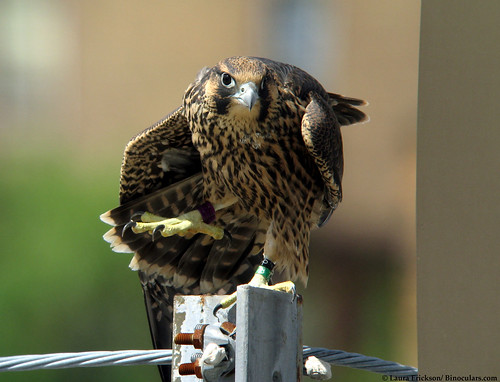 |
Bud Tordoff, who was among the very first people to start Minnesota's
Peregrine Reintroduction Project. This photo was from the
Midwest Peregrine Society, taken the last day Dr. Tordoff was in the field
banding young birds. |
In 1982, Harrison "Bud" Tordoff and several other Minnesotans
banded together to start our state’s Peregrine Falcon Reintroduction Program, which quickly became one of several enormous successes of the Endangered Species Act.
Ten years later, in 1992, when the project was
enjoying its first successes along the North Shore and in a few areas near the
Twin Cities and a couple of mining areas, right when some of the first
reintroduced birds were first trying to nest on the big bridges between Duluth
and Superior, my friend Dudley Edmondson got the idea to put up a peregrine nesting
box in downtown Duluth. He contacted the
Raptor Resource Project of Decorah,
Iowa, and they set up a box on the Greysolon Hotel.
Although that
group is famous for the nest cam they have on their local Bald Eagles, they’ve
never worked out a way to put a cam on the Duluth peregrine box. At first, such
a thing wouldn’t have worked anyway—it took eleven years for a peregrine to
show any interest in the box.
Finally, in 2003, a young female who had hatched from a nest
in Minneapolis showed up, inspecting the box. She didn’t manage to attract a
mate that year, and in the fall, an adult female turned up wanting the box for
herself. She was not banded, and no one knows where she came from—that was
mystifying because every state's peregrine reintroduction program has been, from the start, so effective at
tracking every bird they released; they were banding what they thought were all
of the chicks produced by birds that had come out of the program. Suddenly,
here was a female, seemingly out of nowhere—a Mysterious Stranger. She wanted that nest box, and so she took it.
Tragically, Peregrine Falcons do not watch soap operas, so they
don’t realize that writers are only supposed to inject a murder into the
plotline when the ratings are slumping or they need to write off an actor who
is demanding more pay. The less experienced bird fought for the box without thinking through the ramifications of fighting off an older, savvier
bird, and she didn’t know when to retreat. She ended up dead, giving the Mysterious
Stranger undisputed ownership of the box.
In spring the following year, 2004, again out of the
blue, another Mysterious Stranger arrived on the scene—an unbanded adult male.
 |
| Duluth's unbanded male: Our Mysterious Stranger |
The two birds with unknown pasts did what birds and bees and educated fleas and soap opera stars do,
and soon there were three chicks in the nest box. On fledging, one got into an accident, broke her leg,
and ended up dying at the
Raptor Center. Another was killed by a plane in
Chicago, and the third’s destiny is unknown.
I started working for a company in downtown Duluth in 2005.
I didn’t know any of the Raptor Resource people, but spent a lot of time
watching and photographing the birds as they raised four chicks. I watched one
female make her maiden flight on July 3.
 |
| Right after fledging, this young female ended up in a Duluth parking ramp |
She ended up in a parking ramp, and
after taking a bazillion close-up photos of her and realizing she could not
figure out how to get out of the ramp, I captured her in a towel, managed to
get up on the roof of the NorShor Theater, and released her there. During the
following few weeks, the four chicks spent a lot of time in the park along the
Lake Walk, and I got more photos before they finally disappeared for the year. I later found out, based on her band number, that the Raptor Resource Project people had named the young female I rescued Maggie. None
of that year's chicks' destinies are known.
I followed Duluth’s Peregrine Falcons pretty
carefully while I worked downtown, but the company I was working for relocated, and I knew I wouldn’t be able to keep such good tabs on the birds in
2006. I was very concerned about the difficulties many young urban falcons face
when they first fledge. They often ended up grounded, like Maggie had, because
they don’t have the wide-open spaces of their natural cliff environments that
allow them to work their wings without obstructions when they're taking their first flights. And urban buildings are
not only big obstructions—they’re often covered with glass that the birds don’t
see, making collisions even more likely. Urban fledglings often need a bit of help
until they grow savvier and develop more flying skills.
So I contacted
Hawk Ridge Bird Observatory suggesting that we needed a regular downtown presence as
an organization. It seemed worthwhile to work with people tied in with the
Raptor Resource Project, too, so we could get more information about the
nestlings each year. People downtown were already excited about these
magnificent birds—giving them information about them along with tips on how to
help them if they got grounded seemed good for everyone and sure enough, that’s
how it turned out when Hawk Ridge started their wonderful Peregrine Watch
program. Julie O’Connor became the first face of the project, got the program
off to a resounding start in 2006, and her solid knowledge and effervescent
enthusiasm made Peregrine Watch an instant success.
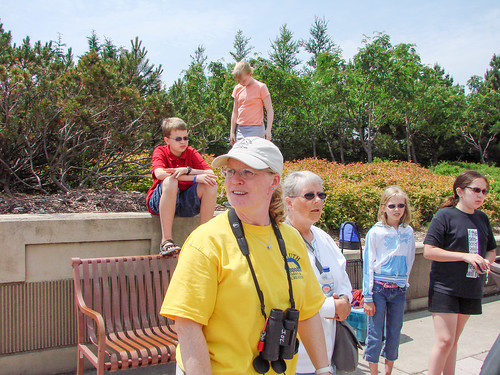 |
| Julie O'Connor at Lake Place Park in Duluth during the 2006 Peregrine Watch program. |
That year, the same two Mysterious Stranger peregrines showed
up again, and again raised four chicks. This time, Julie and others from
Peregrine Watch were downtown at Lake Place Park just about every day, with a
scope on the nest and close up photos of the birds—hundreds of Duluthians and
tourists got to see adult peregrines, nestlings, and eventually fledglings up
close and personal, and get accurate information about them. Julie told me ahead
of time when the nestlings were going to be banded and finagled an invitation for
me to join them on the hotel roof.
The
day before, when the banders were sizing up the situation to decide if the
chicks were the right size for banding, the female kept aggressively attacking
them. She grabbed the hat off Raptor Resource Project Director Bob Anderson’s
head, but the next time she swooped in, they plucked her out of the sky and banded her.
 |
| Our female Mysterious Stranger the day after she was banded and given the name Amy |
Now that she was banded, they gave our female Mysterious Stranger an official name, Amy, (named for Amy Ries of the Raptor Resource Project). The unbanded
male, more wisely or less committed to defending his young, has never been
caught. Even today, in 2015, he maintains his Mysterious Stranger mystique.
“Amy” was extremely riled up by the banders,
and the whole time they were working, she screamed all kinds of peregrine
obscenities as well as dive-bombing them, providing me with some dramatic
photos.
 |
| Amy cursing out the banders; her language would have been bleeped out on network TV. |
 |
| The late Rob MacIntyre was smart enough to wear a hard hat--we could hear a few loud clunks! |
I also got plenty of photos of the young and the banding process.
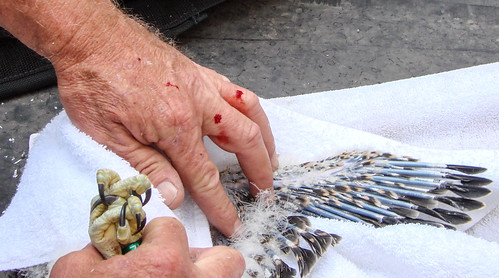 |
| Banding falcons can be a bloody task |
 |
| Julie O'Connor holding one of the newly banded chicks before they were returned safely to the nest box |
Amy and Our Mysterious Stranger continued their summer patterns
for four more summers, through 2010. Each year, Amy laid four eggs. Sadly, in
2008 three of the chicks died from a nasty parasitic disease when very young,
but all in all, this couple successfully fledged 24 young—an amazing track
record.
Then, in 2011, Amy did not return. No one knows what
happened to her—if someone found her injured or dead, we presume her fate would
have been reported to the Bird Banding Laboratory or one of the Peregrine reintroduction groups. Losing her without any knowledge
of what happened is not at all in keeping with what we yearn for in soap
operas, but quite in keeping with a bird who appeared out of the blue one day.
She presumably died sometime between 2010 and 2011. If we were to create a
monument to Amy, both her start and end dates would be
question marks.
Amy’s mate returned, but it’s impossible without a soap
opera soundtrack to guess whether he was devastated from grief, didn’t notice her
absence at all, or felt something in between. Anyone who claims that birds
don’t feel emotions is being completely unscientific, but anyone who claims
that birds feel a specific emotion is being equally unscientific. We simply
have no way of knowing what is going on in their minds or hearts. But we do know that a seven-year-old female banded in
Ontario as a nestling in 2004 showed up and Our Mysterious Stranger accepted
her as a mate.
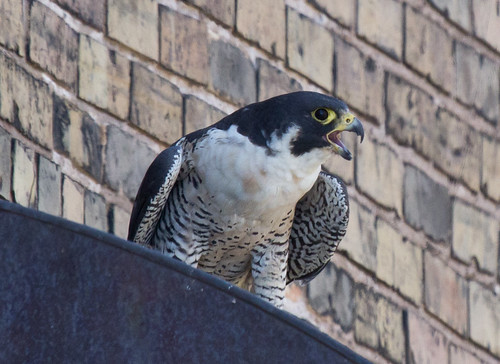 |
| Jenna, the female who turned up in 2011 |
This female was simply called B/8 by the people who banded her.
The people at Peregrine Watch started calling her Canada or Jenna. She and Our
Mysterious Stranger raised two chicks that year. The banders named one
Laura, after me—what a thrill that was!
 |
| "Laura" |
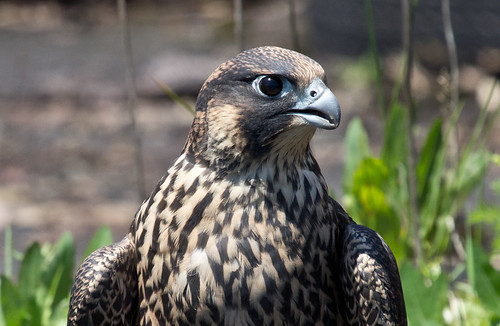 |
| Laura's sister, "Waters." |
Laura got into a bit of a pickle a day or two after she fledged, and needed to be rescued and placed atop the building again—no
one saw her after that day, but we don’t know what happened to her.
 |
| Laura ended up on top of this car, but was retrieved by a local bander and returned to a safe roof top. |
In 2012, spring arrived early enough that Jenna and Our
Mysterious Stranger started the nest two full weeks ahead of schedule. By the
time the banders arrived, the four chicks were too old to be banded without
risking them jumping prematurely from the nest. In 2013, Jenna produced four
eggs, but one didn’t hatch. And in 2014, three of their eggs didn’t hatch.
Their one fledgling that year, a male, was never banded.
We have no idea whatsoever why half their eggs didn’t hatch
those two years. The wet, cold weather both years may have made hunting poor or
kept Jenna off the nest too much, or Our Mysterious Stranger may be reaching
the end of his reproductive peak, and some of his sperm may no longer be
viable. It's also possible that Jenna is producing less viable eggs. Banded, wild Peregrine Falcons have survived over 19 years. Our Mysterious Stranger is, at a minimum, 15 years old now, and could be older—we have no way of
knowing. We do know that Jenna is 11 years old this year.
We had much more favorable conditions for nesting in 2015,
and Jenna and Our Mysterious Stranger appeared right on schedule. But in a sad
plot twist worthy of the finest TV soap, another male turned up, too—a young
guy still approaching his prime, who had been banded as a nestling in Cloquet
two years ago.
Without a soap opera's musical soundtrack, we can’t guess what Jenna
thought about all this. Did she want a new mate to improve her chances of
raising young? Was she simply growing tired of Our Mysterious Stranger, yearning
for a change of pace? Might she have been having a midlife crisis? Whatever she
was thinking, she and the New Kid on the Block set up housekeeping on a
different nest box, further west, on Duluth's Torrey Building. Her own fertility is still something of a question mark: she produced four eggs, but only two hatched.
The new male may be showing superficial politeness to his
elder, may be intimidated by the more experienced unbanded male, or maybe just
hasn’t found a reason to fight, so both males have been hanging around all summer without any noticeable battles.
Our Mysterious Stranger seems mystified by the turn of events—he’s
been seen by many people circling over downtown, carrying food and calling.
That used to be the signal to Jenna that he was bringing provisions to her and
the chicks, and even now, she’s been seen flying up and accepting his gifts—but
then she carries them off to her new nest, and he flies back to the old nest
box on the Greysolon Building alone.
 |
Hawk Ridge's Peregrine Watch is still continuing. Here are Miranda Durbin,
Katie Swanson, and Pip the Birding Dog at Lake Place Park, June 2015. |
When this year’s two chicks were banded, no blood samples
were taken, so we don’t know if the new young male fathered both of them or
whether Jenna was also engaging in a bit of hanky-panky with her reliable old
mate. So in another twist worthy of the finest television soap
opera, the chicks may be siblings or only half siblings—their true parentage is a question in
their mother’s past. Regardless of who their father(s) may be, this year’s
chicks have a better chance than most of surviving, what with having two males
bringing food to their mother.
Like the best of soap operas, the continuing saga of
Duluth’s Peregrine Falcons has no ending in sight. Our Mysterious Stranger is so far the one character who has been part of the storyline from the first season.
We know that, like Mrs. Chancellor or Victor Newman from
The
Young and the Restless or Erica Kane from
All My Children, his pivotal role in our local soap will eventually
come to an end. But as long as Peregrine Falcons continue to fly in Minnesota, this
is one soap opera that will go on and on, regardless of sponsors, and
regardless of ratings. And the offspring Our Mysterious Stranger and Amy and Jenna and The New Kid on the Block have produced
will live on, to produce more young, to ensure more soap opera storylines well
into the future.



